With over 600 consulting projects completed in the social sector, we realized we hold some collective wisdom about social change, how it happens, and what it takes to assess and learn from social change efforts. Here are 25 nuggets of learning that our staff selected to share:
Learnings From Our Work
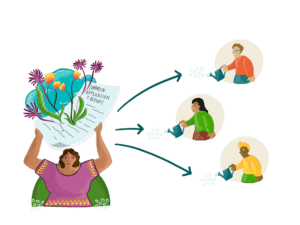 1. For many of our foundation clients seeking to create more trust-based and equitable grantmaking practices, equity commitments require rethinking logistical and operational assumptions (2023). For Gender Funders CoLab, we found it led to common application and reporting forms that resulted in higher quality, more decision-relevant information for them, and time-savings and useful thought exercises for grantees.
1. For many of our foundation clients seeking to create more trust-based and equitable grantmaking practices, equity commitments require rethinking logistical and operational assumptions (2023). For Gender Funders CoLab, we found it led to common application and reporting forms that resulted in higher quality, more decision-relevant information for them, and time-savings and useful thought exercises for grantees.
 2. Summer camps create an amazing opportunity for children and teens to grow and develop (2022). The Foundation for Jewish Camp’s Specialty Camp Incubator created new opportunities for 13,000 Jewish children and teens over the course of 11 summers (every summer from 2010-2021, with the exception of 2020). While the experience may have felt like magic, it was thanks to the carefully planned Jewish and specialty programming, paired with high-quality staff, and a deep commitment to building Jewish community, that campers increased their relationship with Judaism, grew their confidence and maturity, and strengthened skills related to the camp’s specialty. The Incubator left a profound mark on the field of Jewish camp, providing a clear answer that specialty and teen-specific programming can build new markets of teens who had never attended Jewish overnight camp and create lasting impact.
2. Summer camps create an amazing opportunity for children and teens to grow and develop (2022). The Foundation for Jewish Camp’s Specialty Camp Incubator created new opportunities for 13,000 Jewish children and teens over the course of 11 summers (every summer from 2010-2021, with the exception of 2020). While the experience may have felt like magic, it was thanks to the carefully planned Jewish and specialty programming, paired with high-quality staff, and a deep commitment to building Jewish community, that campers increased their relationship with Judaism, grew their confidence and maturity, and strengthened skills related to the camp’s specialty. The Incubator left a profound mark on the field of Jewish camp, providing a clear answer that specialty and teen-specific programming can build new markets of teens who had never attended Jewish overnight camp and create lasting impact.

3. We had the opportunity to work with local government agencies and community-based organizations partnering closely together to tackle the housing crisis in the Bay Area. In 2022, we investigated the Partnership for the Bay’s Future (PBF) model to increase community participation and voice in the efforts to alleviate the housing crisis. A capable Fellow, dedicated funds, a cohort of peers, and a suite of technical assistance tools set in motion a deeper relationship between government and community.
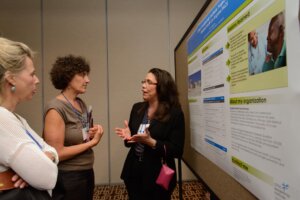 4. Investment in leadership development is a critical philanthropic tool for field building and, ultimately, systems change (2021).We had the opportunity to work on a longitudinal study that followed 10 cohorts of Clinic Leadership Institute alumni for the Blue Shield of California Foundation. Published in The Foundation Review, our study “Investing in Leadership Development: A Tool for Systems Change in the Community Health Center Field,” found the Institute served a critical role in supporting community health center leaders and their organizations in navigating change, while also supporting alumni networks in their advocacy for community health centers in county- and state-level policy.
4. Investment in leadership development is a critical philanthropic tool for field building and, ultimately, systems change (2021).We had the opportunity to work on a longitudinal study that followed 10 cohorts of Clinic Leadership Institute alumni for the Blue Shield of California Foundation. Published in The Foundation Review, our study “Investing in Leadership Development: A Tool for Systems Change in the Community Health Center Field,” found the Institute served a critical role in supporting community health center leaders and their organizations in navigating change, while also supporting alumni networks in their advocacy for community health centers in county- and state-level policy.
 5. Our work with Open Mind Consulting in 2020-2021 for the Hewlett Foundation’s Performing Arts Program showed that “intermediaries” aren’t just re-grantors: they nurture ecosystems of support, providing networking and marketing support, conference and convening opportunities, professional development for artists and educators, and fiscal sponsorship.
5. Our work with Open Mind Consulting in 2020-2021 for the Hewlett Foundation’s Performing Arts Program showed that “intermediaries” aren’t just re-grantors: they nurture ecosystems of support, providing networking and marketing support, conference and convening opportunities, professional development for artists and educators, and fiscal sponsorship.
 6. Structuring grantmaking work by program content area is often misaligned with the urgent need to work across sectors to drive complex systems change (2020). We learned this from our work with the Kresge Foundation, from which we wrote about a publication – “Collaborating Within to Support Systems Change: The Need For — and Limits of — Cross-Team Grantmaking” – for The Foundation Review; the image you see here is a Kresge staff member’s concept sketch about the process of making a cross-team grant.
6. Structuring grantmaking work by program content area is often misaligned with the urgent need to work across sectors to drive complex systems change (2020). We learned this from our work with the Kresge Foundation, from which we wrote about a publication – “Collaborating Within to Support Systems Change: The Need For — and Limits of — Cross-Team Grantmaking” – for The Foundation Review; the image you see here is a Kresge staff member’s concept sketch about the process of making a cross-team grant.
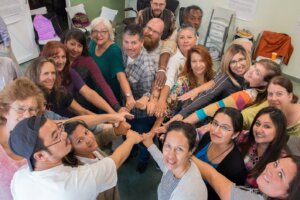 7. Distributed leadership practices are one way organizations can create conditions for more equitable and inclusive workplaces (2018). We learned this through developing case studies of distributed leadership in practice at arts organizations such as California Shakespeare Theater, Denver Center for Performing Arts, Destiny Arts Center, On the Move, Orpheus Chamber Orchestra, Terrain, and Thousand Currents. Read more here on that work done in partnership with Open Mind Consulting and the William and Flora Hewlett Foundation.
7. Distributed leadership practices are one way organizations can create conditions for more equitable and inclusive workplaces (2018). We learned this through developing case studies of distributed leadership in practice at arts organizations such as California Shakespeare Theater, Denver Center for Performing Arts, Destiny Arts Center, On the Move, Orpheus Chamber Orchestra, Terrain, and Thousand Currents. Read more here on that work done in partnership with Open Mind Consulting and the William and Flora Hewlett Foundation.
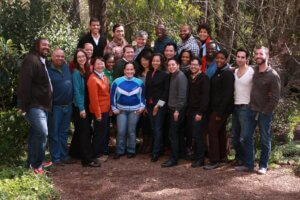 8. Investing in emerging leaders’ capabilities to practice self-care, deepen their self-awareness, and strengthen their connections to others contributed to them thriving in current and new leadership roles in LGBTQ movement organizations (2012). Increasing leadership diversity is crucial for advancing equity and inclusion. What helps LGBTQ leaders thrive? While working on an evaluation of The Pipeline Project’s 21st Century Fellows program for emerging LGBTQ leaders, we investigated the relative helpfulness to fellows of various aspects of the program. There was a clear throughline between aspects of the program that helped leaders practice self-care and self-awareness skillsets and their growth as more confident leaders who felt a strong sense of purpose in their roles and connections to the LGBTQ movements.
8. Investing in emerging leaders’ capabilities to practice self-care, deepen their self-awareness, and strengthen their connections to others contributed to them thriving in current and new leadership roles in LGBTQ movement organizations (2012). Increasing leadership diversity is crucial for advancing equity and inclusion. What helps LGBTQ leaders thrive? While working on an evaluation of The Pipeline Project’s 21st Century Fellows program for emerging LGBTQ leaders, we investigated the relative helpfulness to fellows of various aspects of the program. There was a clear throughline between aspects of the program that helped leaders practice self-care and self-awareness skillsets and their growth as more confident leaders who felt a strong sense of purpose in their roles and connections to the LGBTQ movements.
 9. Building the capacity of after-school education programs requires strong champions and strong relationships (2011). Our mixed methods evaluation of technical assistance provision to after-school programs by the David and Lucile Packard Foundation from 2007-10 allowed us to triangulate information from a variety of sources and capture a wide range of perspectives over time in the absence of existing comprehensive statewide data. The top learning from the evaluation was the importance of strengthening existing TA infrastructure, cementing relationships, and supporting program champions.
9. Building the capacity of after-school education programs requires strong champions and strong relationships (2011). Our mixed methods evaluation of technical assistance provision to after-school programs by the David and Lucile Packard Foundation from 2007-10 allowed us to triangulate information from a variety of sources and capture a wide range of perspectives over time in the absence of existing comprehensive statewide data. The top learning from the evaluation was the importance of strengthening existing TA infrastructure, cementing relationships, and supporting program champions.
10. A learning from our earlier years that didn’t hold up so well during the COVID-19 pandemic? Face-to-face time is required for successful learning communities (2007). We reflected on everything we’ve learned about what makes for a successful learning community in this article for Grantmakers for Effective Organizations (GEO).
11. Coaching is a powerful strategy for cultivating strong leadership and building effective organizations (2005). Our research identified numerous benefits to funding coaching programs for nonprofit leadership.
12. The Cost of a Volunteer (2003): At the behest of the Ewing Marion Kauffman Foundation, we investigated the true costs to nonprofits of recruiting, training, and managing volunteers — uplifting to philanthropy a range of operational expenses too often overlooked by funders and government partners when promoting volunteer service initiatives.
Learnings About the Field

13. Data ethics is a mindset, not a checklist. Data is a tool that can empower or oppress, make visible or erase–depending on how that data is collected and used. However, there is no one-size-fits-all solution for collecting and using data ethically. We published our Data Ethics Guidebook and Toolkit to provide evaluators and grantmakers with some best practices and stories—not rules!—to help them collect, analyze, and share back data that is inclusive and representative.
14. Three insights about issues of compensation in evaluation practice. While preparing the Data Ethics Guidebook, we took a deep dive into the ethics of compensation for participants in evaluations. Compensating those who participate in data collection activities is a necessary piece of equitable evaluation and should take into account the intensity of the activity (e.g., participating in a 90-minute focus group should be compensated more than filling out a 5-minute survey), the life disruption necessary to participate (e.g., whether contributing is part of someone’s regular job responsibilities vs. requiring them to miss work), and logistics (e.g., whether participation required travel or scheduling). Compensation and incentives should be large enough to benefit participants, but, just as importantly, not so large that it might pressure vulnerable participants to participate at a cost to their safety.
15. Demographics are sensitive and private information, yet also vital for unmasking inequities and making sense of the data. Over the past 25 years, we have collected a lot of data from a lot of individuals! Recently, we had the opportunity to take a step back and chat with others in the field about our practices and assumptions (as evaluators and researchers) when collecting this type of information. Associate Inti Chomsky dove deeper into this topic as part of our “Data Ethics Week” takeover on the American Evaluation Association’s AEA365 blog.
 16. “Objectivity” has many meanings and a troubling history. Since Informing Change’s founding, attacks on science and facts have grown exponentially. We are often tempted to respond with vigorous defenses of “objectivity” in evaluation, but it is important to differentiate between “Truth” (singular, omniscient) and “truths” (multiple, situated, grounded) in evidence of many kinds. For more, take a look at Director Anjie Rosga’s series of posts on “Trust & Numbers,” or listen to her interview about objectivity in evaluation on Dana Wanzer’s EvaluLand podcast.
16. “Objectivity” has many meanings and a troubling history. Since Informing Change’s founding, attacks on science and facts have grown exponentially. We are often tempted to respond with vigorous defenses of “objectivity” in evaluation, but it is important to differentiate between “Truth” (singular, omniscient) and “truths” (multiple, situated, grounded) in evidence of many kinds. For more, take a look at Director Anjie Rosga’s series of posts on “Trust & Numbers,” or listen to her interview about objectivity in evaluation on Dana Wanzer’s EvaluLand podcast.
 17. Reports come in many shapes, looks, and feels: it’s not just the typical 40-page evaluation report anymore; web-design, artwork, and visual storytelling can also be used to tell a story! On our Reproductive Justice Impact project with the Groundswell Fund, we had the chance to work with Teal Media and Audrey Pray to build a microsite to tell an evaluation story instead of a “report.”
17. Reports come in many shapes, looks, and feels: it’s not just the typical 40-page evaluation report anymore; web-design, artwork, and visual storytelling can also be used to tell a story! On our Reproductive Justice Impact project with the Groundswell Fund, we had the chance to work with Teal Media and Audrey Pray to build a microsite to tell an evaluation story instead of a “report.”
18. We all have survey fatigue, yet surveys remain a mainstay of research and evaluation as a tried-and-true way to collect uniform information across large or dispersed groups. How can we shift this approach and ensure there is enough data to yield meaningful results? We have tried a few things, including printing surveys on paper for audiences to complete at events, keeping feedback surveys short (5 or 10 questions max!), including a limited number of closed-ended questions in an interview or focus group, and of course, offering incentives to the people who complete surveys. What have you tried?
19. A tool needn’t be fully original, nor used to address what it was designed for, to be valuable. We came across the “TIERS Tool for Allocating Evaluation Resources at Nonprofit Agencies” when Jewish Family and Children’s Services internal evaluators Laura Beals and Rachel Albert presented it at the annual American Evaluation Association conference in 2014. They had created it to help them think through how to allocate evaluation dollars across 44 different programs to answer the most relevant questions for each one’s stakeholders. It helpfully differentiates between “tiers” of evaluation from monitoring to impact assessment and research. We share it with clients at least a few times each year when they want to jump into impact assessment before they’re ready. It’s simple, clear, and colorful and it makes a great communication tool.
20. Being intentional and transparent about how we center equity and what we mean by equity is an important part of every evaluation. We’ve learned from multiple projects that explored equity issues that it is crucial to define what the actors in an evaluation mean by equity and to communicate that transparently. Intrigued? Check out these two videos we produced for Expanding the Bench’s CREE (Culturally Responsive and Equitable Evaluation) Learning Series featuring Director Michael Arnold:
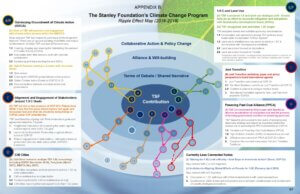 21. The Power of Ripple Effect Mapping (REM). REM combines elements of appreciative Inquiry, affinity sorting, and visual mind-mapping activities to elucidate the often invisible, unplanned, and insufficiently recognized outcomes of complex multi-stakeholder change initiatives. We used it to map the influence of the Stanley Center for Peace & Security on climate policy advocacy. The method’s power to illuminate unseen pathways to policy effectiveness and to help participants learn new things about one another’s contributions blew us away. Read about our work with REM with three different Stanley teams here.
21. The Power of Ripple Effect Mapping (REM). REM combines elements of appreciative Inquiry, affinity sorting, and visual mind-mapping activities to elucidate the often invisible, unplanned, and insufficiently recognized outcomes of complex multi-stakeholder change initiatives. We used it to map the influence of the Stanley Center for Peace & Security on climate policy advocacy. The method’s power to illuminate unseen pathways to policy effectiveness and to help participants learn new things about one another’s contributions blew us away. Read about our work with REM with three different Stanley teams here.
22. We’ve learned that as our sector increasingly understands the value of many kinds of diversity to the health and resilience of systems, it may be time to re-visit the central place that concepts like “shared identity” or being “united behind a common goal” hold in frameworks for assessing the strength of fields and movements. Our projects sometimes ask us to explore how, and to what extent, a field or movement, is emerging, evolving, or growing. Several frameworks for defining a “strong field” exist. However, in recent years, our data point to a potential problem with these frameworks: they typically over-emphasize a requirement for a “shared identity” and a “common goal” among the individuals and organizations that make up the field. In our experience, organizations and individuals who identify as part of a field or movement often celebrate its diversity of identities, viewing this as a marker of strength. This has been true in everything from our evaluations of more narrowly defined academic fields (where agreeing to disagree with one another is celebrated and seen as a marker of freedom of thought) to social justice movements (where grassroots actors see tremendous value in incorporating a wide range of goals and approaches that are responsive to local needs and contexts).
Learnings About Our Company
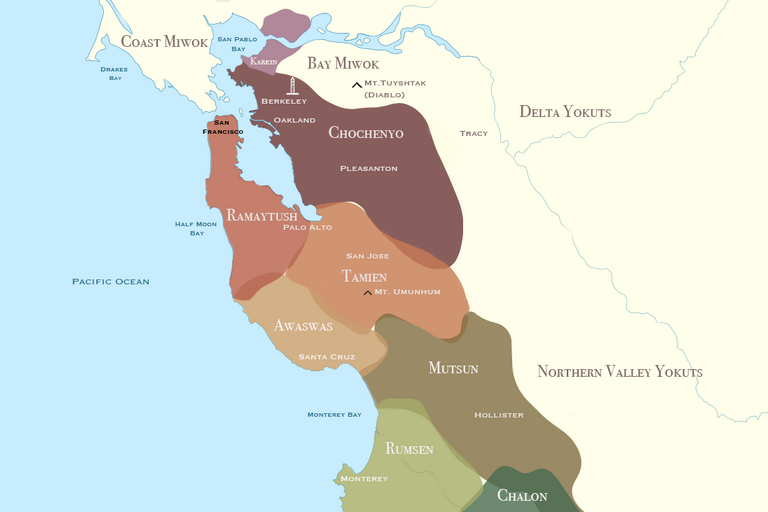 23. We live and work on stolen land. As part of our own internal REDI/JEDI work, we explicitly acknowledged the Huichin territory, on the traditional homelands of the Chochenyo-speaking Ohlone people, on which we work. (Ohlone territories map image comes from the UC Berkeley Centers for Education Justice & Community Engagement website.)
23. We live and work on stolen land. As part of our own internal REDI/JEDI work, we explicitly acknowledged the Huichin territory, on the traditional homelands of the Chochenyo-speaking Ohlone people, on which we work. (Ohlone territories map image comes from the UC Berkeley Centers for Education Justice & Community Engagement website.)
24. Processes are tools, not rules. As a company that’s been around for 25 years, it’s important we have consistent procedures to ensure we have a shared understanding and process. Our policies and procedures range from internal (time off requests, calendar management) to external use (project management, deliverable templates). We remind staff these are tools and it’s fine if they deviate from them if the purpose is the same. Is your fellow team member able to understand what you are conveying? Over time, we learned to adapt our procedures to changing times and situations. Remember when we used to print everything out and organize them in binders? Today we are mostly paperless except for the occasional hard copy of a report.
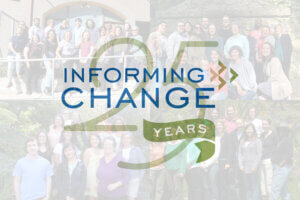 25. “We live our values. We value each other.” This is our culture. “We live our values” encapsulates our explicit company values. “We value each other” represents the implicit values we have at Informing Change: that we take care of one another and ourselves, celebrate each other, and challenge each other’s ideas and thinking.
25. “We live our values. We value each other.” This is our culture. “We live our values” encapsulates our explicit company values. “We value each other” represents the implicit values we have at Informing Change: that we take care of one another and ourselves, celebrate each other, and challenge each other’s ideas and thinking.

